
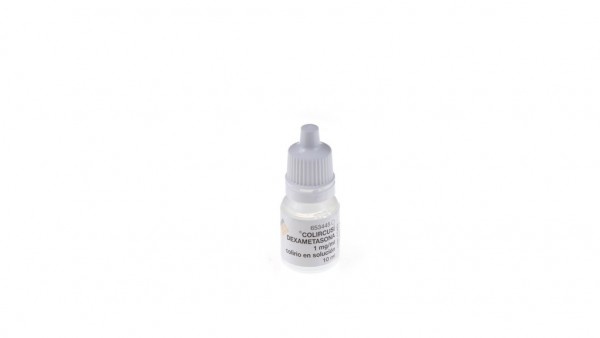
ДЕКСАМЕТАЗОН ПОС 1 мг/мл КРАПЛІ ОЧНІ, РОЗЧИН

Запитайте лікаря про рецепт на ДЕКСАМЕТАЗОН ПОС 1 мг/мл КРАПЛІ ОЧНІ, РОЗЧИН

Інструкція із застосування ДЕКСАМЕТАЗОН ПОС 1 мг/мл КРАПЛІ ОЧНІ, РОЗЧИН
Вступ
Опис: інформація для пацієнта
Дексаметазон ПОС 1 мг/мл офтальмологічний розчин
Дексаметазон метасульфобензоат натрію
Прочитайте уважно весь опис перед тим, як почати використовувати цей лікарський засіб, оскільки він містить важливу інформацію для вас.
- Збережіть цей опис, оскільки вам може знадобитися знову його прочитати.
- Якщо у вас виникли питання, проконсультуйтеся з вашим лікарем або фармацевтом.
- Цей лікарський засіб призначений тільки вам, і його не слід давати іншим людям, навіть якщо вони мають такі самі симптоми, як і ви, оскільки це може їм нашкодити.
- Якщо ви відчуваєте побічні ефекти, проконсультуйтеся з вашим лікарем або фармацевтом, навіть якщо це побічні ефекти, які не вказані в цьому описі. Див. розділ 4.
Зміст опису
- Що таке Дексаметазон ПОС і для чого він використовується
- Що потрібно знати перед тим, як почати використовувати Дексаметазон ПОС
- Як використовувати Дексаметазон ПОС
- Можливі побічні ефекти
- Збереження Дексаметазону ПОС
- Зміст упаковки та додаткова інформація
1. Що таке Дексаметазон ПОС і для чого він використовується
Дексаметазон ПОС - це глюкокортикоїд для місцевого лікування ока.
Дексаметазон ПОС використовується для лікування неінфекційних запальних процесів в очах, які реагують на кортикостероїди, таких як алергічні захворювання очей, запальні захворювання кон'юнктиви, запалення рогівки та переднього сегмента ока; післяопераційні запалення.
2. Що потрібно знати перед тим, як почати використовувати Дексаметазон ПОС
Не використовуйтеДексаметазон ПОС
- якщо ви алергічні на дексаметазон метасульфобензоат натрію або на інші компоненти цього лікарського засобу (перелічені в розділі 6),
- у разі гострого герпесу (кератиту) та інших вірусних інфекцій ока,
- у разі бактеріальних та/або грибкових інфекцій ока без відповідної антибіотичної терапії,
- у разі пошкоджень або виразок рогівки,
- у разі глаукоми з вузьким кутом та глаукоми з широким кутом,
- у разі ослаблення імунної системи через захворювання або лікарські засоби.
Попередження та обережність
Проконсультуйтеся з вашим лікарем або фармацевтом перед тим, як почати використовувати Дексаметазон ПОС.
У разі попереднього захворювання на герпес або операції на оці цей лікарський засіб повинен застосовуватися тільки під суворим медичним контролем.
Коли цей лікарський засіб використовується протягом 10 днів або більше, ваш лікар повинен регулярно перевіряти внутрішньоочний тиск та рогівку.
Для уникнення можливої системної реабсорбції, особливо у маленьких дітей, потрібно закрити слізний канал пальцем протягом 2-3 хвилин після застосування цього лікарського засобу.
Проконсультуйтеся з вашим лікарем, якщо ви відчуваєте набухання та збільшення ваги навколо тулуба та на обличчі, оскільки ці є зазвичай першими проявами синдрому Кушинга. Пригнічення функції наднирників може розвинутися після закінчення тривалого або інтенсивного лікування цим лікарським засобом. Проконсультуйтеся з вашим лікарем перед тим, як самостійно припинити лікування. Ці ризики особливо важливі у дітей та пацієнтів, які приймають лікарські засоби, що називаються ритонавіром або кобіцистатом.
Зв'яжіться з вашим лікарем, якщо ви відчуваєте розмитість зору або інші порушення зору.
Використання Дексаметазону ПОС з іншими лікарськими засобами
Повідомте вашому лікареві або фармацевту, якщо ви приймаєте, нещодавно приймали або можете приймати інші лікарські засоби.
Використання цього лікарського засобу разом з деякими лікарськими засобами, які впливають на нервову систему, такими як атропін, може призвести до додаткового збільшення внутрішньоочного тиску.
Повідомте вашому лікареві, якщо ви приймаєте ритонавір або кобіцистат, оскільки це може збільшити кількість дексаметазону в крові.
Попередження:
При поєднаному лікуванні з іншими місцевими офтальмологічними лікарськими засобами повинен бути інтервал у 15 хвилин між застосуваннями різних продуктів. Масти завжди повинні застосовуватися в останню чергу.
Вагітність та годування грудьми
Якщо ви вагітні або годуєте грудьми, вважаєте, що можете бути вагітною або плануєте вагітність, проконсультуйтеся з вашим лікарем або фармацевтом перед тим, як використовувати цей лікарський засіб.
Немає підтверджених даних про використання цього лікарського засобу під час вагітності. Оскільки глюкокортикоїди можуть викликати вади розвитку плода в дослідженнях на тваринах, цей лікарський засіб повинен використовуватися під час вагітності тільки за суворими показаннями.
Не відомо, чи може місцеве застосування цього лікарського засобу привести до виявлення дексаметазону в грудному молоці через системну реабсорбцію. Відомо, що при системному застосуванні глюкокортикоїдів виявляються кількості, які проходять до грудного молока, і можуть викликати порушення росту дитини. Тому цей лікарський засіб повинен використовуватися під час годування грудьми тільки за суворими показаннями.
Водіння транспортних засобів та використання машин
Не водьте транспортні засоби безпосередньо після застосування цього лікарського засобу, оскільки він зменшує зір протягом короткого часу та, відповідно, зменшує час реакції при русі. Також не дозволяється тимчасово керувати електроінструментами або машинами.
Дексаметазон ПОСмістить
Цей лікарський засіб містить дексаметазон метасульфобензоат натрію як активну речовину, яка може викликати алергічні реакції. Повідомте вашому лікареві, якщо ви маєте алергію.
Видаліть контактні лінзи перед застосуванням цього лікарського засобу та чекайте хоча б 20 хвилин перед тим, як знову їх вдягнути.
3. Як використовувати Дексаметазон ПОС
Слідуйте точно інструкціям з застосування цього лікарського засобу, вказаним вашим лікарем або фармацевтом. У разі сумнівів проконсультуйтеся з вашим лікарем або фармацевтом.
Якщо ваш лікар не вказав інше, рекомендується наступна доза:
3-5 разів на добу (у гострих випадках частіше), 1 крапля в кон'юнктивальну сумку.
Для забезпечення терапевтичного ефекту лікування не повинно перериватися до встановленого терміну. Ваш лікар визначить тривалість лікування. Якщо лікування триває більше 2 тижнів, очі повинні регулярно перевірятися вашим лікарем. У будь-якому разі слід уникати тривалого лікування без медичного контролю.
Як застосовувати Дексаметазон ПОС
Вимийте руки.

Пункт 1: Візьміть чистий рушник та м'яко витріть слізну рідину з нижньої частини ока.
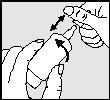
Пункт 2: Видаліть кришечку перед кожним застосуванням. Перед першим застосуванням Дексаметазону ПОС тримайте контейнер вертикально з кінчиком вниз та натисніть на основу до появи першої краплі на дозаторі. Тепер контейнер готовий до використання.
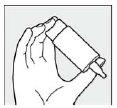
Пункт 3: Тримайте контейнер з дозатором вниз, так щоб великий палець тиснув на плече контейнера, а інші пальці розміщувалися на основі.
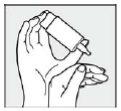
Пункт 4: Опорі руку, якою ви тримаєте контейнер COMOD®, на руку, якою ви вільні, так як показано.

Пункт 5: Нахилийте голову трохи назад, м'яко потягніть нижню повіку вниз та сильно та швидко натисніть на основу контейнера. Таким чином активується механізм для виділення краплі. Завдяки спеціальній технології клапана системи COMOD® розмір та швидкість краплі однакові, незалежно від тиску, який здійснюється. Під час застосування уникайте контакту кінчика контейнера з оком або шкірою. Повільно закрийте очі, щоб рідини рівномірно розподілялися по поверхні ока.

Пункт 6: Після застосування Дексаметазону ПОС мигайте кілька разів, щоб розподілити краплю по всій поверхні ока. Після цього видаліть надлишок лікарського засобу.
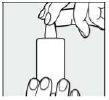
Пункт 7:
Після застосування негайно закрийте кришечку. Перевірте, чи сухий кінчик дозатора.
Повторіть цю процедуру в іншому оці.
Розподіляйте застосування Дексаметазону ПОС рівномірно протягом дня.
Якщо ви використовуєте більшеДексаметазону ПОС, ніж потрібно
На даний час не відомі симптоми отруєння через передозування в оці. У разі передозування місцевого застосування промийте око водою. Якщо відбулося випадкове пероральне прийняття лікарського засобу (наприклад, у дітей), потрібно випити воду (½ склянки) для розчинення. Зазвичай не потрібні додаткові заходи. Однак у разі маленьких дітей слід проконсультуватися з лікарем.
У разі передозування або випадкового прийняття лікарського засобу негайно проконсультуйтеся з вашим лікарем або фармацевтом або зверніться до Токсикологічної служби, телефон 91 562 04 20, вказавши лікарський засіб та кількість, прийняту.
Якщо ви забули використовуватиДексаметазон ПОС
Не використовуйте подвійну дозу, але застосуйте так скоро, як це можливо, ту саму кількість та з тією самою частотою, описаною вище або призначеною вашим лікарем.
Якщо у вас є інші питання щодо використання цього лікарського засобу, проконсультуйтеся з вашим лікарем або фармацевтом.
4. Можливі побічні ефекти
Як і всі лікарські засоби, цей лікарський засіб може викликати побічні ефекти, хоча не всі люди їх відчувають.
Для оцінки побічних ефектів визначаються наступні частоти появи:Дуже часті: більше 1 з 10 пацієнтів, які приймають лікарський засібЧасті: від 1 до 10 з 100 пацієнтів, які приймають лікарський засібНечасті: від 1 до 10 з 1000 пацієнтів, які приймають лікарський засібРідкі: від 1 до 10 з 10 000 пацієнтів, які приймають лікарський засібДуже рідкі: менше 1 з 10 000 пацієнтів, які приймають лікарський засібЧастота невідома: не може бути оцінена на основі доступних даних
Не відомо частота появи наступних побічних ефектів.
Проблеми з гормонами: збільшення волосся на тілі (особливо у жінок), слабкість та в'ялість м'язів, пурпурні смуги на шкірі, збільшення артеріального тиску, нерегулярні або відсутні менструації, зміни рівня білків та кальцію, пригнічення росту у дітей та підлітків, набухання та збільшення ваги тіла та обличчя (синдром Кушинга) (див. розділ 2).
Офтальмологічні розладиТривале лікування може викликати збільшення внутрішньоочного тиску у пацієнтів з особливою схильністю. Тому рекомендується регулярно контролювати внутрішньоочний тиск. Крім того, під час тривалого лікування може виникнути незворотна опacidad рогівки (катаракта).
Попередня інфекція може бути маскована або загострена. Одночасно слід враховувати можливість вторинної інфекції під час тривалого лікування, особливо якщо ознаки хронічної інфекції зберігаються незважаючи на лікування. У разі захворювань, які викликають тоншення рогівки, лікування може призвести до перфорації.
Відомі випадки алергічних реакцій, таких як подразнення шкіри з червоним свербженням та свербінням в оці (дерматит, кон'юнктивіт та екзема повіки).Офтальмологічні краплі, які містять дексаметазон, сповільнюють загоєння ран. Якщо офтальмологічні краплі, які містять кортизон, використовуються після операції на катаракті, загоєння рани може бути сповільнено. Тривале лікування цим лікарським засобом також може сповільнити загоєння ран.
Після застосування офтальмологічних крапель, які містять глюкокортикоїди, можуть розвинутися реакції гіперчутливості з запальними симптомами, виразками рогівки, розширенням зіниці, порушеннями акомодації (фокусування) та птозом (опущенням верхньої повіки ока).Крім того, може виникнути тимчасове свербіння та печіння в оці, а також подразнення ока, розмитість зору, відчуття стороннього тіла та алергічні реакції.
Сповіщення про побічні ефекти:
Якщо ви відчуваєте будь-які побічні ефекти, проконсультуйтеся з вашим лікарем, фармацевтом або медсестрою, навіть якщо це можливі побічні ефекти, які не вказані в цьому описі. Ви також можете повідомити про них безпосередньо через Систему моніторингу лікарських засобів України: https://www.notificaram.es. Інформуючи про побічні ефекти, ви можете допомогти надати більше інформації про безпеку цього лікарського засобу.
5. Збереження Дексаметазону ПОС
Тримайте цей лікарський засіб поза досяжністю дітей.
Не використовуйте цей лікарський засіб після закінчення терміну придатності, вказаного на упаковці після CAD. Термін придатності - останній день місяця, який вказано.
Не зберігайте при температурі вище 25 °C.
Інформація про термін придатності після відкриття:
Дексаметазон ПОС можна використовувати протягом 4 тижнів після першого відкриття.
Лікарські засоби не слід викидати в каналізацію або сміття. Відкладайте упаковки та лікарські засоби, які вам не потрібні, в пункті збору фармацевтичного сміття. У разі сумнівів проконсультуйтеся з вашим фармацевтом, як позбутися упаковок та лікарських засобів, які вам не потрібні. Таким чином, ви допоможете захистити довкілля.
6. Зміст упаковки та додаткова інформація
Склад Дексаметазону ПОС
- Активна речовина - дексаметазон метасульфобензоат натрію 1,0 мг/мл
- Інші компоненти - гіпромелоза, гліцерол та вода для ін'єкцій.
Вигляд продукту та вміст упаковки
Дексаметазон ПОС випускається в упаковці з системою безповітряного дозування, яка містить 5 мл офтальмологічного розчину прозорого та безбарвного. Кожна коробка містить одну упаковку.
Наповнення упаковки здійснюється під регулярним контролем, щоб виключити наповнення меншою кількістю розчину.
Власник реєстраційного посвідчення та виробник
Власник реєстраційного посвідчення
BRILL PHARMA, S.L.
C/ Munner, 8
08022, Барселона
Іспанія
Виробник
URSAPHARM Arzneimitel GmbH
Industriestraße 35,
66129 Саарбрюкен,
Німеччина
Дата останнього перегляду цього опису:Жовтень 2019
Детальна та актуальна інформація про цей лікарський засіб доступна на сайті Державної служби України з лікарських засобів: http://www.dls.gov.ua/
- Країна реєстрації
- Діючі речовини
- Потрібен рецептТак
- Виробник
- Інформація є довідковою і не є медичною порадою. Перед прийомом будь-яких препаратів обов'язково проконсультуйтеся з лікарем. Oladoctor не несе відповідальності за медичні рішення, прийняті на основі цього контенту.
- Альтернативи до ДЕКСАМЕТАЗОН ПОС 1 мг/мл КРАПЛІ ОЧНІ, РОЗЧИНФорма випуску: ОЧНІ КРАПЛІ, 1 мг/млДіючі речовини: dexamethasoneПотрібен рецептФорма випуску: ОЧНІ КРАПЛІ, 0,1 %Діючі речовини: dexamethasoneВиробник: Fidia Farmaceutici S.P.A.Потрібен рецептФорма випуску: ОЧНІ КРАПЛІ, 1 мг/млДіючі речовини: dexamethasoneВиробник: Laboratoires TheaПотрібен рецепт
Аналоги ДЕКСАМЕТАЗОН ПОС 1 мг/мл КРАПЛІ ОЧНІ, РОЗЧИН в інших країнах
Найкращі аналоги з тією самою діючою речовиною та терапевтичним ефектом.
Аналог ДЕКСАМЕТАЗОН ПОС 1 мг/мл КРАПЛІ ОЧНІ, РОЗЧИН у Польща
Аналог ДЕКСАМЕТАЗОН ПОС 1 мг/мл КРАПЛІ ОЧНІ, РОЗЧИН у Україна
Лікарі онлайн щодо ДЕКСАМЕТАЗОН ПОС 1 мг/мл КРАПЛІ ОЧНІ, РОЗЧИН
Консультація щодо дозування, побічних ефектів, взаємодій, протипоказань та поновлення рецепта на ДЕКСАМЕТАЗОН ПОС 1 мг/мл КРАПЛІ ОЧНІ, РОЗЧИН – за рішенням лікаря та згідно з місцевими правилами.














